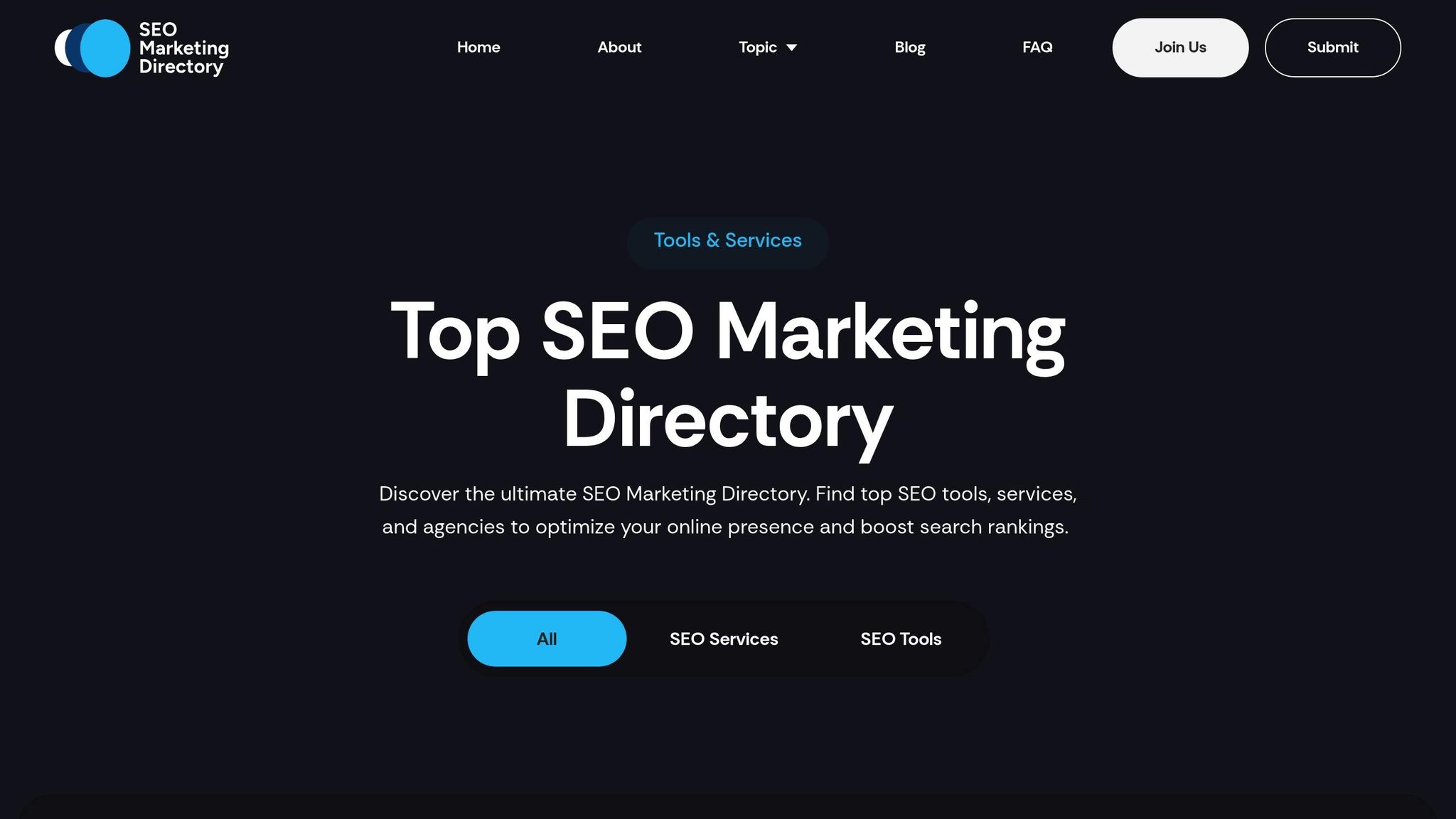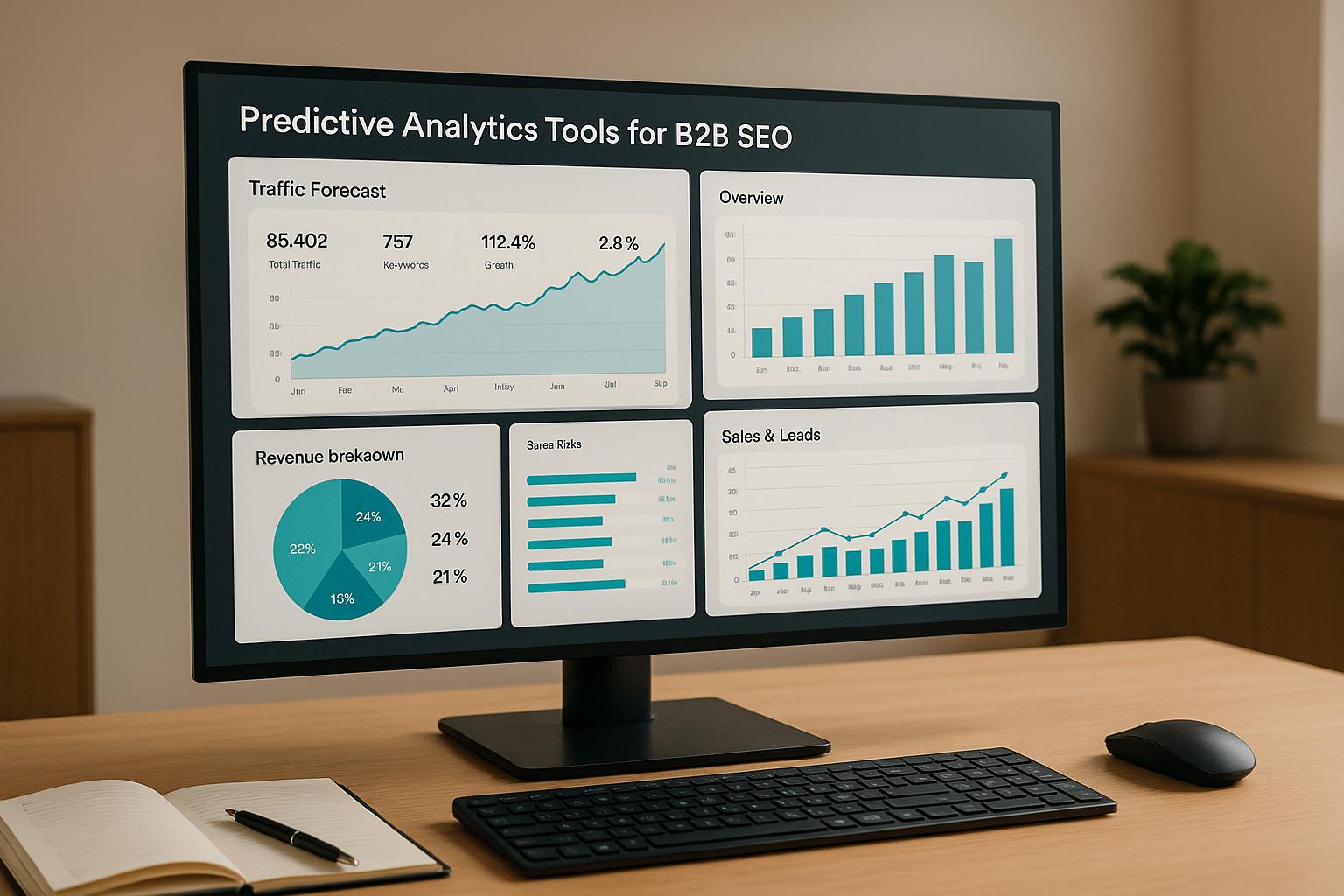AI multilingual keyword research helps businesses find and optimize keywords across multiple languages and regions, enabling them to expand their reach globally. Unlike traditional keyword research, this approach uses advanced AI tools to analyze search behavior, intent, and local preferences in various markets. Here's what you need to know:
- What It Is: AI tools analyze keywords beyond simple translations, considering search intent, cultural differences, and local competition.
- Why It Matters: Most internet users don’t speak English. Multilingual SEO can help businesses connect with these audiences, driving organic traffic and conversions.
- How It Works: AI speeds up keyword research by processing large datasets, identifying trends, and automating workflows across languages.
Key Tools for AI Multilingual Keyword Research
- SEMrush: Ideal for multilingual campaigns with keyword tracking and content gap analysis.
- Ahrefs: Great for backlink and keyword analysis in diverse markets.
- Jasper AI: Generates localized keyword variations for content strategies.
- ChatGPT/GPT-4: Brainstorms keyword ideas and clusters for different languages.
- DeepL Write: Assists in mapping keywords across languages.
Process Overview
- Select Target Markets: Identify regions and languages with strong growth potential.
- Discover Keywords: Use AI tools to generate and analyze keyword variations.
- Validate Keywords: Ensure accuracy, relevance, and alignment with local search behavior.
- Monitor Performance: Continuously refine strategies based on data.
AI tools make multilingual SEO faster, more accurate, and scalable, helping businesses succeed in global markets.
Keyword Research Across Languages: Localizing for International SEO
Core Concepts and Requirements for Multilingual SEO
Understanding language differences - like the contrast between American and British spelling - is a key part of multilingual keyword research. This level of detail is especially important in U.S. markets, where search patterns are shaped by American English preferences.
U.S.-Specific Localization Factors
When conducting research for U.S. audiences, sticking to standard American spelling is essential. For example, terms like "color" (instead of "colour"), "organize" (instead of "organise"), and "center" (instead of "centre") align with how users in the U.S. typically search online. Including these variations can improve visibility and broaden your reach.
Top AI Tools for Multilingual Keyword Research
Harnessing the potential of AI for multilingual SEO can open up a world of opportunities. These tools are designed to analyze data across multiple languages, uncovering keyword insights that traditional methods might miss. They also address the challenges of manual research, making global keyword strategies more efficient.
Overview of Leading AI Platforms
- SEMrush: Known for its broad range of SEO tools, SEMrush excels in keyword research and tracking. It’s particularly useful for multilingual campaigns, helping identify keyword variations and content gaps across different languages.
- Ahrefs: Famous for its detailed backlink and keyword analysis, Ahrefs uses advanced algorithms to assess keyword difficulty and traffic potential. It’s a powerful tool for uncovering opportunities in diverse language markets.
- Jasper AI: This platform leverages language models to generate localized keyword variations and long-tail phrases, making it a valuable asset for content localization workflows.
- ChatGPT and GPT-4: These conversational AI tools are excellent for brainstorming keyword ideas, creating keyword clusters, and capturing nuances specific to different cultures and languages.
- DeepL Write: While primarily a translation tool, DeepL Write can assist in cross-language keyword mapping by identifying subtle semantic relationships between terms.
When to Use These Tools
The right tool depends on your goals and expertise in multilingual SEO. For detailed competitor analysis and regional search insights, SEMrush and Ahrefs are solid choices, though they require some learning. If you’re looking for quick, accessible options, ChatGPT offers a straightforward way to generate keyword ideas and explore cultural nuances. Meanwhile, Jasper AI and DeepL Write can refine your strategies for content localization, ensuring your messaging resonates across languages.
How the Top SEO Marketing Directory Can Help

The Top SEO Marketing Directory is a one-stop resource for businesses navigating multilingual SEO. It offers curated listings of AI-powered tools, complete with expert reviews, making it easier to choose the right platform for your needs.
In addition to tools, the directory highlights reputable SEO agencies specializing in multilingual keyword research. This ensures you get expert advice on selecting and implementing the best solutions, streamlining your global SEO efforts with confidence and precision.
sbb-itb-5be333f
Step-by-Step AI Multilingual Keyword Research Process
Here's a detailed guide to conducting multilingual keyword research with the help of AI tools. By breaking the process into clear phases, you can use these tools effectively to expand your reach across global markets.
Identifying Target Languages and Regions
Start by determining which languages and regions to focus on. This step is crucial for a successful global expansion. Use your existing traffic data to identify markets where there’s strong interest in your products or services.
Next, assess the market potential. AI tools like ChatGPT can help you explore industry trends, competition levels, and consumer behavior in specific regions. For example, if you’re in e-commerce, you could ask: "What are the top 5 emerging markets for [your product category] in 2025, and what are the key consumer preferences in each region?"
Don’t forget to account for language variations. For instance, Spanish is spoken in Spain, Mexico, Argentina, and Colombia, but each region has unique vocabulary and search behaviors. Similarly, English is used in the US, UK, Canada, and Australia, yet search habits differ widely between these countries.
Finally, consider resource allocation. Rank potential markets based on factors like market size, competition, and your budget for localization efforts. Start with 2-3 key markets, and expand gradually as you gain experience and resources.
Using AI for Keyword Discovery and Analysis
Once you’ve identified your target markets, it’s time to dive into keyword research. Begin by generating seed keywords based on your primary English terms. AI platforms like ChatGPT or Jasper AI can help brainstorm variations. For example, you might ask: "What are 20 different ways people in Germany might search for [your product] online?"
Pay attention to search intent mapping, as cultural nuances can significantly impact how people search. For instance, Americans might look for "cheap flights", while Germans might search for "günstige Flüge" or "billige Flüge", each with slightly different meanings and intent.
AI tools are also great for identifying keyword opportunities. Use them to analyze competitor performance, spot seasonal trends, and uncover long-tail keywords that are often overlooked but can offer easier entry into new markets.
Organize your findings with keyword clustering. AI can group related keywords by topic, intent, and difficulty, making it easier to plan content strategies and identify gaps in your multilingual SEO efforts.
Validating Keywords Across Languages
Once you’ve compiled and organized your keywords, it’s essential to validate them for accuracy and relevance. AI tools are helpful here, but combining their insights with local expertise ensures a well-rounded approach.
Start with search volume verification. While AI tools provide estimates, these can vary between platforms and regions. Use Google Keyword Planner as a baseline, and supplement with data from local search engines like Baidu for China or Yandex for Russia.
Competition assessment is another critical step. A keyword might seem low-competition globally but could face intense local competition. AI can identify these local competitors and analyze their strategies, giving you valuable insights into what works in specific markets.
Don’t overlook technical validation. Ensure your keywords fit within your website’s technical constraints. For instance, German keywords are often longer due to compound words, which could impact URL structures or metadata limits.
Lastly, use AI for performance prediction. These tools can estimate potential traffic and conversions based on historical data from similar industries and markets. This helps you set realistic goals and allocate your localization budget effectively.
For additional accuracy, consult local SEO professionals through resources like the Top SEO Marketing Directory. Their expertise adds a human touch that complements AI insights, ensuring your strategy resonates with real users.
Finally, establish a system for monitoring and adjustment. Track how your keywords perform compared to AI predictions and refine your approach based on actual results. Combining AI efficiency with human oversight and feedback is the key to long-term success in multilingual SEO.
Advanced Strategies and Future Trends in Multilingual SEO
Building on earlier discussions about AI-driven keyword research, the world of multilingual SEO is taking a significant leap forward with the integration of predictive analytics and advanced natural language processing (NLP). These cutting-edge tools are reshaping how businesses approach global markets, offering new opportunities to stay ahead in an increasingly competitive digital landscape.
Predictive Analytics and Real-Time Trend Insights
Predictive analytics is transforming how businesses anticipate search behaviors across different languages and regions. By analyzing massive datasets, AI systems can identify seasonal trends and regional events well in advance. For example, while U.S. consumers search for "Black Friday deals" in November, German audiences ramp up searches for "Weihnachtsgeschenke" (Christmas gifts) in early December. These insights allow businesses to position their content strategically.
Real-time trend analysis is another game-changer for multilingual SEO. AI tools track social media conversations, news cycles, and search queries across various languages to spot emerging topics. This is particularly useful in fast-moving industries like fashion, technology, and entertainment, where trends often cross borders but require localized terminology.
The rise of voice search adds another layer of complexity. For instance, Spanish speakers often use more formal phrasing in voice searches compared to the casual tone common among English speakers. Understanding these differences can help businesses fine-tune their content for better engagement.
One of the most advanced applications is cross-language correlation analysis, where AI identifies how trends in one language market might influence others. For example, a viral topic in English-speaking markets could spark similar interest in Spanish-speaking regions, albeit with a time delay. This insight enables businesses to roll out multilingual content strategies in a phased and coordinated manner.
Advancements in NLP and Large Language Models
Large Language Models are revolutionizing how businesses understand search behavior across cultures. These models can detect subtle differences in user intent behind similar keywords. For example, while "cheap hotels" in English appeals to budget-conscious travelers, the Spanish equivalent "hoteles baratos" might carry negative connotations in certain regions, where "hoteles económicos" would be a better choice.
Modern NLP systems excel at recognizing idiomatic expressions, regional slang, and local references, which are often missed by traditional keyword research methods. This is particularly valuable for markets like Latin America, where Spanish varies significantly between countries, or for targeting English-speaking audiences across continents.
Semantic clustering has also become more advanced. AI can now group keywords not only by topic but by the deeper needs they represent across languages. This helps businesses uncover content opportunities that might otherwise go unnoticed when analyzing markets individually.
Another breakthrough is entity recognition across languages. AI systems can identify when different terms refer to the same product, brand, or concept. This is crucial for businesses operating under different brand names in various regions or for products with distinct names but similar purposes across cultures. These advancements are paving the way for highly personalized and dynamic SEO strategies.
Future Trends Shaping Multilingual SEO
Looking ahead, the next wave of AI-powered multilingual SEO tools will focus on hyper-personalization. These systems will move beyond broad audience segmentation, recognizing that, for instance, a bilingual user in Miami searches differently than a monolingual Spanish speaker in Madrid.
Automated content localization is also evolving. Instead of merely translating text, AI tools are adapting content to align with local preferences, incorporating appropriate references, imagery, and even structural changes to resonate with specific audiences.
Another emerging trend is cross-platform integration. Future tools will combine data from search engines, social media, e-commerce platforms, and voice assistants to create unified multilingual strategies. This comprehensive approach will provide deeper insights into how users interact with content across different channels.
Real-time optimization is becoming more sophisticated as well. Rather than relying on periodic keyword updates, AI systems will continuously monitor performance and suggest adjustments to multilingual strategies as search behaviors and competitive landscapes shift.
The growing importance of visual and voice search optimization presents both challenges and opportunities. AI tools are beginning to understand how to adapt visual and audio content for different cultural contexts, ensuring these elements go beyond simple linguistic translation.
Finally, privacy-first approaches are shaping the future of SEO. As data protection laws vary by country, AI tools are finding ways to conduct effective keyword research while respecting local regulations and attitudes toward data privacy.
For practical advice on implementing these trends, the Top SEO Marketing Directory offers curated tools and expert resources. Their selection of AI-powered platforms ensures you're equipped with the latest advancements in predictive analytics and natural language processing to elevate your multilingual SEO strategies.
Conclusion and Key Takeaways
AI has reshaped the way multilingual keyword research is conducted, offering a faster, more precise approach to building global SEO strategies. By applying the advanced methods discussed, businesses can harness AI's potential to create more targeted and effective campaigns.
How AI Enhances Multilingual Keyword Research
In the past, traditional keyword research methods could take weeks to complete. Today, AI processes massive amounts of data in just hours. It also adapts in real time to shifting trends, helping businesses stay connected with their audiences by identifying subtle differences in user intent across various languages.
Another game-changer? AI significantly reduces costs. Instead of hiring entire teams of native speakers or regional SEO experts for every market, businesses - big or small - can use AI tools to understand local search behaviors. This levels the playing field, allowing smaller companies to compete globally without the need for massive budgets.
AI also scales effortlessly. Whether you're targeting a handful of languages or dozens, AI tools maintain consistent quality across tasks like keyword discovery, competitor analysis, content gap identification, and performance tracking. This scalability makes selecting the right tools a critical step for success.
Why the Top SEO Marketing Directory Matters
As mentioned earlier, the Top SEO Marketing Directory can be a valuable resource for businesses looking to streamline their AI-driven multilingual SEO efforts. It provides expert recommendations and a carefully curated list of SEO tools, making it easier to find the right solutions for global initiatives.
The directory includes tools designed to tackle technical SEO issues and deliver detailed analytics - both essential for managing multilingual websites. By utilizing this trusted resource, businesses can navigate the complexities of global SEO more efficiently and set the stage for growth on an international scale.
FAQs
How do AI tools help businesses account for cultural differences in multilingual keyword research?
AI tools play a pivotal role in helping businesses fine-tune their multilingual keyword research. They dive deep into local search behavior, identifying popular phrases, idioms, and colloquialisms to make sure the content resonates naturally with the audience in each target market. These tools also analyze regional search trends, uncover seasonal patterns, and take into account cultural nuances, ensuring the content stays relevant and visible in specific locations.
By tapping into the power of AI, businesses can craft content that not only reflects local preferences but also boosts SEO performance across various regions. Plus, these tools help ensure compliance with cultural expectations and legal standards, making marketing strategies more effective and respectful of local norms.
What challenges do businesses face with AI-driven multilingual SEO, and how can they address them?
Businesses often face hurdles like inconsistent translations when relying on AI for multilingual SEO. AI tools can stumble over linguistic subtleties, leading to translations that miss the mark. This not only creates a poor user experience but can also harm search engine rankings. On top of that, subpar translations often fail to reflect the cultural and regional nuances crucial for effective communication.
To overcome these challenges, incorporating quality control measures is key. For example, having human editors review and refine AI-generated translations can significantly enhance the output. On the technical side, using advanced AI models trained on diverse, high-quality datasets can help improve both accuracy and consistency. By blending AI capabilities with human expertise, businesses can create a more effective and seamless multilingual SEO strategy.
How do predictive analytics and real-time trends improve multilingual SEO strategies?
Predictive analytics empowers marketers to anticipate upcoming search trends, making it easier to pinpoint high-performing keywords and distribute resources more efficiently. By preparing campaigns before trends hit their peak, businesses can maintain an edge over competitors and stay ahead of the curve.
On the other hand, real-time trend insights allow marketers to fine-tune content and keyword strategies quickly, responding to shifts in user behavior and cultural dynamics as they happen. This flexibility is especially crucial for multilingual SEO, ensuring that content stays relevant and resonates across various languages and regions. Together, these tools help boost visibility, increase engagement, and elevate search rankings in diverse markets.


